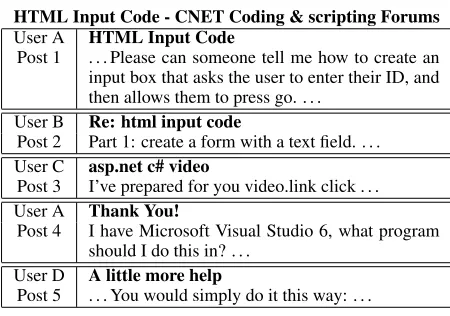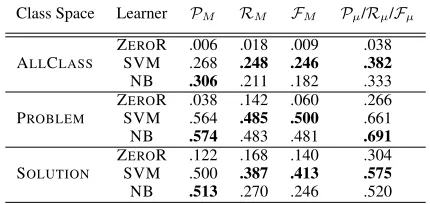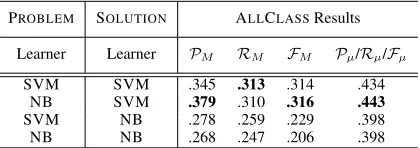Thread-level Analysis over Technical User Forum Data
Li Wang, Su Nam Kim and Timothy Baldwin NICTA VRL
Department of Computer Science and Software Engineering University of Melbourne
VIC 3010 Australia
li.wang.d@gmail.com, sunamkim@gmail.com, tb@ldwin.net
Abstract
This research focuses on improving in-formation access over troubleshooting-oriented technical user forums via thread-level analysis. We describe a modular task formulation and novel dataset, and go on to describe a series of preliminary classifi-cation experiments over the data. We find that a class composition strategy achieves the best results, surpassing multiclass clas-sification approaches.
1 Introduction
Online forums and discussion boards are online platforms for people to hold discussions in particu-lar domains. They are widely used in various areas such as customer support, community develop-ment, interactive reporting and online education. Forums provide one of the primary avenues for online users to share information on the Internet. Users post their questions or problems onto on-line forums and get possible solutions from other users. Through this simple mechanism, great vol-umes of data with customised answers to highly specialised domain-specific questions are created on a daily basis. However, it is not an easy job to extract the information latent in the threads.
The aim of our research is to help users to more easily access existing information in forums which relate to their questions, by text mining troubleshooting-oriented, computer-related tech-nical user forum data (Baldwin et al., 2010). An example thread from a real-world forum is shown in Figure 1, which is made up of4 posts with 3 distinct participants.
Our proposed strategy is to model the “content structure” of forum threads by analysing requests for information and provision of solutions in the thread data. We devise an ontology of problem sourcesandsolution typeswith which to analyse
HTML Input Code - CNET Coding & scripting Forums User A HTML Input Code
Post 1 . . . Please can someone tell me how to create an input box that asks the user to enter their ID, and then allows them to press go. . . .
User B Re: html input code
Post 2 Part 1: create a form with a text field. . . . User C asp.net c# video
Post 3 I’ve prepared for you video.link click . . . User A Thank You!
Post 4 I have Microsoft Visual Studio 6, what program should I do this in? . . .
User D A little more help
[image:1.595.306.531.204.362.2]Post 5 . . . You would simply do it this way: . . .
Figure 1: An extract from a real-world thread
individual threads, paving the way for users to spell out the general nature of their support need in their queries. The main contributions of this pa-per are: (1) designing a modular thread-level class set; (2) constructing and publishing an annotated dataset; and (3) performing preliminary thread-level experiments over the dataset.
2 Related Work
There is very little work that is specifically tar-geted at the thread-level analysis of web user fo-rum data. The most closely-related work is that performed by Baldwin et al. (2007), and our thread class set was created based on this original work.
Rambow et al., 2004; Wan and McKeown, 2004).
3 Class Definition
The proposed thread class set is made up of two or-thogonal Basic Class sets (BASIC), and a Miscel-laneous Class set (MISC). The first BASIC class set is Problem Source (PROBLEM), which con-cerns the targets and sources of the problem de-scribed in threads. It contains 6 basic classes:
Operating System(OS),Hardware,Software, Me-dia,Network andProgramming. The second BA -SICclass set is Solution Type (SOLUTION), which describes the types of the solution presented in threads in the form of4 classes: Documentation,
Install, SearchandSupport. The MISC class set includes two classes:OtherandSpam. A detailed description of each class in the thread class set is presented in Table 1.
A given thread is labelled either with one class label from each of the two BASIC class sets (i.e. two class labels in total), or alternatively one class label from the MISC class set. For example, the thread from Figure 1 would be labelled as Pro-gramming/Documentation. Therefore, when do-ing the actual annotation, we used the ALLCLASS
class set containing 26 classes in total, i.e. the cross product of the two BASIC class sets plus
OtherandSpam.
It should be noted that while the design of our class set is specific to computer-related techni-cal user forum threads, the idea of the two or-thogonal BASICclass sets, namely PROBLEMand
SOLUTION, can be applied to troubleshooting-oriented forum threads from other domains. This is because most troubleshooting-oriented forum threads present one or more problems (i.e. PROB
-LEM), and imply possible solution types (i.e. SO
-LUTION), even if the thread is unresolved.
4 Data Collection
This research focuses exclusively on data from CNET forums.1 Firstly, 1000 threads were crawled from CNET forums using SiteScraper.2 We only collected threads that contained2 to16 posts, as threads containing only 1 post have no answers and cannot provide solutions, and long threads tend to be more discussion-oriented and/or contain multiple sub-threads.
1http://forums.cnet.com
2http://sitescraper.googlecode.com/
The crawled threads were then preprocessed. Only the title and sub-forum information of each thread, and the body, title, and author informa-tion of each post were preserved. Finally, we ran-domly selected500threads from4sub-forums of the CNET forums: Operating Systems, Software,
Hardware, andWeb Development.
Two annotators performed a pilot annotation us-ing a seed set of150threads and a dedicated web annotation tool. The κ value for the pilot anno-tation (indicating the relative agreement between the two annotators) was 0.43. The annotators sat down together to go over every thread where there were disagreements, and discussed the disagree-ments based on the class descriptions. Then, the two annotators annotated327new threads, achiev-ing a more respectableκvalue of0.74. The anno-tators furthermore met again to resolve any dis-agreements in the labelling of the 327 threads. Most of the disagreements arose from confusion betweenHardwareandMediain the PROBLEMset, and Documentation andSupport in the SOLUTION
set.
5 Experimental Methodology
We carried out preliminary experiments over the annotated data, focusing on the implications of the modular class design for thread classification.
As our feature representation, we firstly re-moved all punctuation in the threads and nor-malised the threads to lower case. Then, we lemmatised the threads using the GENIA Tagger
(Tsuruoka et al., 2005), and removed stopwords.3 Based on the preprocessed threads, we used a bag-of-words term frequency representation, concate-nating all posts in the thread into a single meta-document and thereby treating the task as a docu-ment categorisation task.
All of our experiments were carried out us-ing Hydrat (Lui and Baldwin, 2009), a classi-fier comparison framework. Hydratintegrates sev-eral machine learning software packages includ-ing BSVM (Hsu and Lin, 2006), weka (Hall et al., 2009) andMALLET(McCallum, 2002), in ad-dition to native implementations of a number of more basic learners. In our experiments, we tried a range of machine learning models including Support Vector Machines (SVM), multinominal Naive Bayes (NB), and instance-based learners
3Using the stop word list from InfoMap (http://
Class Category Description PROBLEM: OS Operating system
Hardware Core computer components, including core external components (e.g. a keyboard)
Software Software-related issues, including applications and programming tools
Media Hardware which is either a non-standard external component or peripheral device
Network Network issues (e.g. connection speed, and installing a physical network)
Programming Coding and design issues relating to programming
SOLUTION: Documentation How to use a certain function, select a computer/component, or perform a task
Install How to install a component
Search Search for a particular component (e.g. a software package)
Support How to fix a problem with a computer or component
MISC: Other Troubleshooting-related, but the problem source is not included in the PROBLEMset
[image:3.595.71.536.64.197.2]Spam The thread is not troubleshooting-related
Table 1: The components of the thread class set
(NN). A majority-class model (ZEROR) was used as the baseline.
The class set was represented in three ways, based on its two orthogonal components: (1) all26 multiclasses (ALLCLASS); (2) only the PROBLEM
class sub-set, theOtherclass and theSpamclass, comprising8classes in total (PROBLEM); and (3) only the SOLUTIONclass sub-set, theOtherclass and theSpamclass, comprising 6classes in total (SOLUTION). By combining the outputs of classi-fiers based on the PROBLEMand SOLUTIONclass sub-sets (i.e. class composition), it is possible to construct full ALLCLASS classes, and we addi-tionally compare the single-pass multiclass clas-sification strategy with multi-pass class composi-tion.
All experiments were carried out based on strat-ified 10-fold cross-validation. The results were evaluated via both micro-statistics and macro-statistics. Micro-statistics describe average per-formanceper instance(i.e. thread), as represented in the micro-averaged precision (Pµ), recall (Rµ)
and F-score (Fµ). Macro-statistics, on the other hand, describe average performance per class, as represented in the macro-averaged precision (PM), recall (RM) and F-score (FM). It should
be noted that the Pµ, Rµ and Fµ are always
the same, as the prediction per document is al-ways unique. Moreover, because cross-validation is used, the averaged FM is not necessarily the harmonic mean of the averagedPM andRM.
Because we were more interested in the clas-sification effectiveness per thread, the micro-averaged F-score (Fµ) was used as our primary
evaluation method. We also tested the statistical significance of the results using randomised esti-mation withp <0.05(Yeh, 2000).
Class Space Learner PM RM FM Pµ/Rµ/Fµ
ZEROR .006 .018 .009 .038 ALLCLASS SVM .268 .248 .246 .382
NB .306 .211 .182 .333 ZEROR .038 .142 .060 .266 PROBLEM SVM .564 .485 .500 .661 NB .574 .483 .481 .691
ZEROR .122 .168 .140 .304 SOLUTION SVM .500 .387 .413 .575
NB .513 .270 .246 .520
Table 2: The performance of different learners over ALLCLASS, PROBLEMand SOLUTION
6 Results and Evaluation
We performed a series of experiments by applying the learners described in Section 5 over the three class sets (i.e. ALLCLASS, PROBLEMand SOLU
-TION). Because NN performed significantly be-low the other two learners in all experiments, we only present results from SVM and NB (along with baseline ZEROR). The performance of dif-ferent learners over ALLCLASS, PROBLEM and SOLUTION is shown in Table 2. For each class
space, the best result for each column is presented inboldface.
There are several things to note in the results presented in Table 2. First, we can see that the majority class (ZEROR) results are quite poor, es-pecially for ALLCLASS. This is due to the effects of cross-validation, in learning the majority class from the training data in each fold, but due to rel-ative class uniformity, often finding that this is not the majority class in the test data. Second, SVM has relatively strong performance over all three tasks, especially in ALLCLASS and SOLUTION
with the best Fµ scores. This is not surprising,
[image:3.595.309.524.240.342.2]PROBLEM SOLUTION ALLCLASSResults
Learner Learner PM RM FM Pµ/Rµ/Fµ
SVM SVM .345 .313 .314 .434 NB SVM .379 .310 .316 .443
[image:4.595.78.288.63.137.2]SVM NB .278 .259 .229 .398 NB NB .268 .247 .206 .398
Table 3: Results for class composition of the sep-arate predictions from the PROBLEM and SOLU
-TIONclassifiers
it is interesting to note that NB produces the best
Fµ (i.e. 0.691) in the PROBLEM task. Although this figure is not significantly better than the Fµ
(i.e. 0.661) from SVM, it still may imply that we should optimise our methodology over each sub-task.
As is explained in Section 5, the main pur-pose of the experiments is to examine whether the modular class set (i.e. PROBLEM and SOLU
-TIONas two orthogonal components of the overall ALLCLASS) has the potential to benefit the
clas-sification task for ALLCLASS. One simple way is to explore class composition. To be specific, as PROBLEM and SOLUTION represent orthogo-nal components of ALLCLASS, it is possible to perform classification separately over PROBLEM
and SOLUTION, and compose predictions via a combined class set, to form the ALLCLASS class
set. For example, if a given thread is predicted to have a PROBLEMclass ofHardwareand a SOLU
-TIONclass ofDocumentation, we can compose the
two predictions into theHardware/Documentation
class. In order to map the results back onto the ALLCLASS class set cleanly, we used the com-bined class set, where the combination of Other
from either PROBLEM or SOLUTION with any other class from the second class set produces an overall classification of Other in the ALLCLASS
set, and the combination ofSpam/Spamis treated asSpam.
The combined results for the ALLCLASS class set are presented in Table 3, with the best outcome for each column once again indicated inboldface. From the results we can see that the composi-tion of NB for PROBLEM and SVM for SOLU -TIONyields the bestFM (i.e. 0.316) andFµ(i.e.
0.443), significantly improving over the best ALL -CLASS results from Table 2 (0.246 and 0.382 re-spectively). It would therefore appear to be the case that class composition is effective in boosting overall classification performance.
7 Conclusion
This research is aimed towards improving infor-mation access over troubleshooting-oriented tech-nical user forum data, focusing on automated thread-level analysis of the problem sources and solution types. As first steps in this direction, we designed a modular thread-level class set, anno-tated 327 threads, and performed thread classifica-tion over the data. We proposed a class composi-tion strategy by first performing classificacomposi-tion sep-arately over the PROBLEM and SOLUTION class sets, and composing the predictions into an over-all thread classification. This approach gives us the best classification performance overall, with an
Fµof 0.443, well above the best result from doing
the ALLCLASSclassification directly.
Much more work could be done in terms of feature engineering. This could include new fea-tures such as author name/profile and the num-ber of posts in the thread. We also speculate that noise in the threads, such as typos and incorrect casing/punctuation, reduced overall performance, suggest that text normalisation may help boost our classifiers. Additionally, because of the promising results produced by the class composition strat-egy and the innate structure of our thread class set, we could consider more sophisticated hierar-chical classification methods (Dekel et al., 2004; Tsochantaridis et al., 2005). We leave these for future work.
Acknowledgements
NICTA is funded by the Australian Government as repre-sented by the Department of Broadband, Communications and the Digital Economy and the Australian Research Coun-cil through the ICT Centre of Excellence program.
References
Timothy Baldwin, David Martinez, and Richard B. Penman. 2007. Automatic thread classification for Linux user forum information access. In Proceed-ings of the 12th Australasian Document Computing
Symposium (ADCS 2007), pages 72–79, Melbourne,
Australia.
Timothy Baldwin, David Martinez, Richard Penman, Su Nam Kim, Marco Lui, Li Wang, and Andrew MacKinlay. 2010. Intelligent Linux information ac-cess by data mining: the ILIAD project. In Pro-ceedings of the NAACL 2010 Workshop on Compu-tational Linguistics in a World of Social Media:
#So-cialMedia, pages 15–16, Los Angeles, USA.
Pro-ceedings of the 21st International Conference on
Machine Learning (ICML 2004), Banff, Canada.
Mark Hall, Eibe Frank, Geoffrey Holmes, Bernhard Pfahringer, Peter Reutemann, and Ian H. Witten. 2009. The WEKA data mining software: An update.
ACM SIGKDD Explorations Newsletter, 11(1):10–
18.
Chih-Wei Hsu and Chih-Jen Lin. 2006. BSVM.
http://www.csie.ntu.edu.tw/˜cjlin/ bsvm/.
Thorsten Joachims. 1998. Text categorization with support vector machines: Learning with many rel-evant features. In Proceedings of the 10th
Euro-pean Conference on Machine Learning (ECML’98),
pages 137–142, Chemnitz, Germany.
Marco Lui and Timothy Baldwin. 2009. hy-drat. http://hydrat.googlecode.com. Retrieved on 25/10/2010.
Andrew Kachites McCallum. 2002. MALLET: A machine learning for language toolkit. http:// mallet.cs.umass.edu/.
Ani Nenkova and Amit Bagga. 2004. Facilitating email thread access by extractive summary genera-tion. In Nicolas Nicolov, Kalina Bontcheva, Galia Angelova, and Ruslan Mitkov, editors, Recent Ad-vances in Natural Language Processing III: Selected
Papers from RANLP 2003, pages 287–294. John
Benjamins, Amsterdam, Netherlands.
Owen Rambow, Lokesh Shrestha, John Chen, and Chirsty Lauridsen. 2004. Summarizing email threads. In Proceedings of the 4th International Conference on Human Language Technology Re-search and 5th Annual Meeting of the NAACL
(HLT-NAACL 2004), pages 105–108, Boston, USA.
Ioannis Tsochantaridis, Thorsten Joachims, Thomas Hofmann, and Yasemin Altun. 2005. Large margin methods for structured and interdependent output variables. Journal of Machine Learning Research, 6(Sep):1453–1484.
Yoshimasa Tsuruoka, Yuka Tateishi, Jin-Dong Kim, Tomoko Ohta, John McNaught, Sophia Ananiadou, and Jun’ichi Tsujii. 2005. Developing a robust part-of-speech tagger for biomedical text. In Proceed-ings of the Advances in Informatics - 10th
Panhel-lenic Conference on Informatics, LNCS 3746, pages
382–392, Volos, Greece.
Stephen Wan and Kathy McKeown. 2004. Generating overview summaries of ongoing email thread dis-cussions. InProceedings of the 20th International Conference on Computational Linguistics (COLING 2004), pages 549–555, Geneva, Switzerland.
Yiming Yang and Xin Liu. 1999. A re-examination of text categorization methods. In Proceedings of the 22nd Annual International ACM SIGIR Confer-ence on Research and Development in Information
Retrieval (SIGIR’99), pages 42–49, Berkeley, USA.
Alexander Yeh. 2000. More accurate tests for the sta-tistical significance of result differences. In Pro-ceedings of the 18th International Conference on
Computational Linguistics (COLING 2000), pages
947–953, Saarbr¨ucken, Germany.
Liang Zhou and Eduard Hovy. 2005. Digesting Vir-tual “Geek” Culture: The Summarization of Tech-nical Internet Relay Chats. In Proceedings of the 43rd Annual Meeting of the Association for
Com-putational Linguistics (ACL 2005), pages 298–305,


